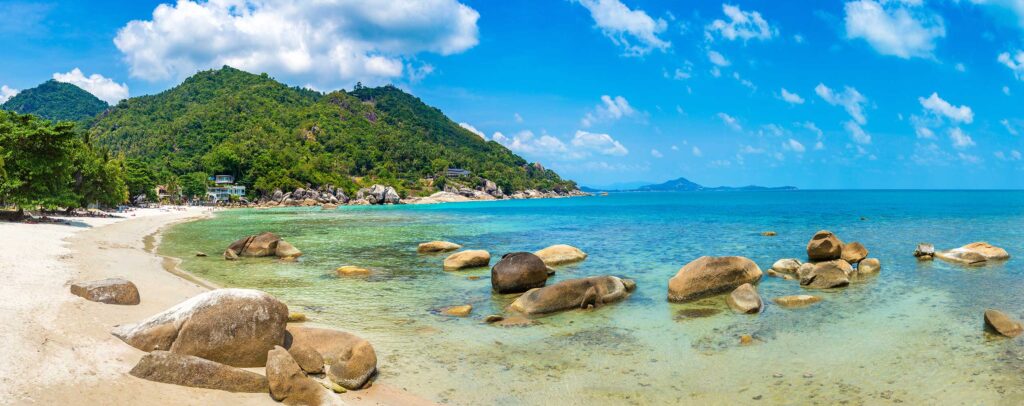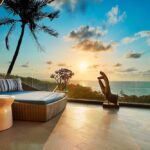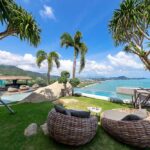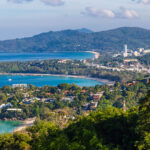Famous for its world class palm fringed beaches, Koh Samui, also known as Ko Samui or Samui, is the second largest island in Thailand after Phuket. Located in the Gulf of Thailand off the mainland’s east coast, the island is only 45 minutes from Bangkok by and a few hours from other major air hubs in Asia such as Singapore and Hong Kong. Koh Samui has a total area of 229 square kilometres and is 25 kilometres across at its widest point. You can comfortably drive around the island in under 2 hours via the 60-kilometre ring road. As air links and infrastructure improved, the island developed from a backpacker’s haven into an internationally renowned resort destination and now attracts as many as a few million visitors per year. With high quality infrastructure and amenities, it now offers a broad spectrum of hotels including many high-end branded resorts, an excellent choice of restaurants, private hospitals, international schools and shopping facilities.
In terms of property types, property for sale in Koh Samui is primarily centred around pool villas, attracting investors looking to enjoy the tropical island lifestyle is primarily cantered around pool villas, attracting investors looking to enjoy the tropical island lifestyle with expansive outdoor living spaces. While the supply of condominiums on the island remains limited due to zoning regulations, Samui saw the release of its first upscale multi-use freehold beach resort condo project, Anava Samui, in mid-2024. However, there are still far fewer freehold condominiums on Samui compared to Phuket, contributing to the focus on villa investments. Property prices have risen alongside gentrification, with average villa prices, excluding the super-luxury segment, now similar to those in Phuket, and top-end properties listed for $8M USD or more.
in 2012 the island was granted municipal status and thus is now locally self-governing, Koh Samui has managed to preserve a lot of its island charm and island-feel with relatively little high-rise development.
Getting There
With its well-serviced international airport positioned only 2km from the island’s main tourist town of Chaweng, travel to Koh Samui is relatively easy. Flights between Suvarnabhumi airport in Bangkok and Koh Samui operate more or less hourly. Direct international flights also connect from Hong Kong, Singapore, Malaysia and mainland China. Domestic flights are also available from Chiang Mai, Krabi, Phuket and Pattaya. The island can also be accessed by ferry from the mainland at Surat Hani and by boat from Chumphon, Koh Tao, and Koh Phangan.
Climate
Though warm throughout the year with monthly daily mean temperatures varying from 27 to 29°C, and on average around 7 hours sunshine each day, the tropical monsoon climate of Koh Samui is localised and drier in comparison to Phuket and southern Thailand in general. The average annual rainfall in Samui is approximately 11% less than that of Phuket, recording 1,960 mm with Phuket having 2,220 mm. The wet season in Samui is also shorter, 2 months long and more concentrated, compared to Phuket’s wet season spanning 6-8 months.
Samui’s wettest months are October and November, sometimes extending a few weeks into December, when prolonged heavy rain lasting many hours is common. For the rest of the year, rain typically lasts a few minutes to an hour, relatively dry for a tropical climate. The driest months in Samui are January to April. February is officially the dry season recording average monthly precipitation below 60 mm.
The best time to visit Samui is often considered to be January to March. From March to May, and particularly in April when they have the Songkran water festival, the heat can be sweltering an oppressive.
Population
Approximately 60,000 people live full time on Samui, a vast majority of the Thai’s being Buddhist. The island population is of course far higher counting the transient tourists.
Geography
Koh Samui is located in the Gulf of Thailand 35 kilometres north-east from the mainland town of Surat Thani. Covering an area of approximately 229 square kilometres, the width of the island varies from 13 to 25 kilometres. It is surrounded the numerous small islands of Ang Thong Marine National Park along with the larger neighbouring islands of Koh Phangan, Koh Tao and Koh Nang Yuan. The coastline varies greatly from pristine white sand, the largest stretch being Chaweng Beach, to striking rocky shoreline. The central part of Koh Samui is largely mountainous tropical jungle, the highest peak being Khao Pom at 635 meters. The island has few rivers flowing year-round and several waterfalls. The various lowland and coastal areas are connected by the islands’ ring road.
Towns and Beaches
Chaweng
Lined with coconut trees, around 4km long with soft deep sand, year-round swimming and having many water sports, Chaweng Beach on the north-east coast is the largest beach and by far the biggest tourist centre of the island. Due to the exceptional quality of its beach, this was the first area to be developed for tourism and the beach road contains a multitude and broad range of accommodation, bars, restaurants, nightlife and shopping to suite all tastes.
Chaweng is located in the most developed north-east region and is within very easy of Samui International Airport, international hospitals and schools, supermarkets, shopping malls and all the most important amenities of the island.
There is only a handful if public rights of way to Chaweng Beach and tourists will normally gain access via one of the beachfront resorts. The most crowded part of the beach is the centre with younger tourists and bars playing music. At the northern end of Chaweng Beach, where it borders Choeng Mon, you can take in the stunning views of the tiny uninhabited island of Koh Matlang. As you head south, it borders with Chaweng Noi and becomes considerably quieter.
Lamai
Located on the south-east coast just 10-mins drive from Chaweng, Lamai is the 2nd busiest tourist town on Samui. The main beach is approximately 3km long with soft and waters that quickly become quite deep, ideal for water sports. Lamai beach and town as more relaxed atmosphere than Chaweng but there is less choice for higher end restaurants and shopping.
Lamai has an interesting backdrop of mountains and at the southerly end there are striking granite rock formations, known as Hinta Hinyai, Making delightful rockpools for kids.
Bo Phut
Centrally located in the most commercially desirable north-east region of the island, Bo Phut is ideally positioned within a very easy reach of Samui International Airport, Chaweng Beach and most of the island’s important facilities and amenities. It also has an excellent stretch of soft sand with deep waters ideal for water sports plus a small pair with boats connecting to the neighbouring islands of Koh Phangan and Kao Tao. A central part of Bo Phut is the charming Fisherman’s Village which has a Mediterranean feel, many chic restaurants and bars plus a tasteful open air shopping mall. As you head west towards the neighbouring town of Maenam, the beach becomes quieter and there are several higher-end resorts.
Choeng Mon
As you had as you head north along the ring road from Chaweng you come to Choeng Mon Beach and Village. Highly sought after for discerning property investors and holiday makers alike, the beach has white ultra-soft sand, shallow waters safe for kids and lovely views of the tiny, deserted island of Koh Farn Noi which you can walk to at low tide. Due to the quality of the beach, the accommodation is now mostly high end. Choeng Mon is very family oriented, with a more relaxed atmosphere than the tourist hub of Chaweng. There are a few bars and a selection of restaurants selling in western food along the beach which offers a beautiful night view over the bay.
Plai Laem
As you continue west along the ring road from Choeng Mon, you come to Plai Laem. Here you will find the active temple of Wat Plai Laem. Finished in the early 2000s, the design has a mix of Thai and Chinese Influences.
Though delivering fantastic sunsets and island views, the main beach of Plai Laem has shallow water and coral so it’s not generally great for swimming but a number of gorgeous small bays and beaches are contained within Plai PLaem including Tongsai Bay, Samrong Beach, Thongson Beach. Conveniently positioned within the Northeast, yet serene, private and away from the crowds of tourists, these neighbourhoods have been chosen as the home of many high-end branded resorts.
Ban Rak
The home of Samui International Airport, Ban Rak is centrally located in the Northeast, between the villages of Plai Laem and Bo Phut. On its eastern shore is the ferry to Koh Phangan, Koh Tai and Angthong National Marine Park. Just 600 west along the coast is one of Samui’s main tourist attractions, Big Buddha Temple. Noticeable as you fly into the island, this magnificent giant golden statue is hard to miss, and Big Buddha is unofficially known to as an area in its own right. Ban Rak Beach is around 3 kilometres long with decent sand and stunning island views of Koh Phangan. There is a good selection a reasonably priced bars and restaurants and the area is a popular choice for expats and backpackers.
Chaweng Noi
Chaweng Noi is on the east coast and borders Chaweng Beach at its southern most point. The bay itself is only about a kilometre long with soft white powder sand. It has a more chilled atmosphere less crowds than the larger beach of Chaweng. The coast road running next to the beach takes a steep climb as you head towards Lamai offering jaw-dropping views back to Chaweng Bay. Along the hillside are many stunning high-end villas taking advantage of the stunning vistas and coastal scenery.
Silver Beach
Not a town or village itself, but simply one of the most beautiful beaches on the island, Silver Beach with its 250-meter stretch of pristine white sand and clear emerald waters dotted with striking granite boulders deserves a mention. Just north of Lamai, the bay has a beautiful green hillside backdrop and offers excellent snorkelling and kayaking.
Maenam
On Koh Samui’s north coast facing Koh Phangan, Maenam borders Bo Phut to the east and Bang Por to the west. The beach has good sand, only a few vendors, deep water ideal for water sports, year-round swimming and captivating island views. Maenam Village is tiny and underdeveloped compared to other tourist areas on Samui with only a few bars and restaurants. In the hillside is one of the main island attractions, the Santiburi Country Club with its glorious sea view 18-hole championship golf course set within a conserved coconut plantation.
Ban Tai
Situated on the islands tranquil northwest coast between the larger beaches of Maenam Bang Por, Ban Tai is a small less developed beach, about 500 meters long and only 15 meters wide at low tide, with soft sand and shallow sea. Great for kids to play safely in the shallow water, this is not one of the main tourist areas. The atmosphere has more of a local feel, like Samui used to be, with a selection of lovely reasonably priced local restaurants.
Bang Por
With fine soft sand, shallow waters and stunning sunset island views to Koh Phangan and Angthong National Marine Park, Bang Por occupies an unspoilt stretch of shoreline on the island’s less developed north-west coast. This is a tranquil setting without much nightlife and just a small selection of Thai restaurants and local beach cafes, yet it is also conveniently positioned just 5 minutes from Maenam Beach and Samui’s business town of Nathon. It also where you will find the exclusive Four Seasons and Mimosa resorts.
Lipa Noi
Off the beaten track of the general tourist, Lipa Noi Beach is on the Samui’s west coast just 5km south of the island’s business centre of Nathon Town. At the southern end of the beach is the Raja Ferry with boats to the mainland. The other ferry terminal to the mainland is just 6km north in Nathon Town. A tranquil location with a long stretch of pristine white sand, swaying coconut palms and year-round swimming, Lipa Noi Beach is also where you will find some of the island’s most exclusive beach front villas. Lipa Noi is not an area with a great deal of nightlife but there is a reasonable selection of lovely local restaurants and this is also the home of Nikki Beach Club, Koh Samui.
Hua Thanon
As you head south from Lamai on the ring road you come to Hua Thanon which has a quaint traditional fishing village with old wooden 2 storey shop houses, seafood market and Muslim community. Just beyond the village is Hua Thanon Beach with its fine soft sand and shallow water, perfect for kids. Due to the quality of the beach, Hua Thanon is one of the areas in the south of the island where you will find a selection of beach front villas.
Taling Ngam
An excellent place to unwind and enjoy a slower pace of life, Taling Ngam is located in Koh Samui’s tranquil south-west region. Taling Ngam Beach has shallow water, rocks and coral. Hence it is not an ideal swimming beach for your average tourist. However, it offers magnificent sunset sea views over the collection of rocks known as the Five Islands plus the neighbouring southerly islands of Koh Madsum and Koh Taen.
Laem Set
Located on the south-east coast next to Hua Thanon and 10 minutes from Lamai, Laem Set Beach is a quite area with few tourists and just a handful of upscale resorts, private villas and local restaurants. The beach is sandy with shallow water and striking granite boulders which separate it into a few small coves. It is also the home of a few local attractions, the Tiger Zoo/Samui Aquarium and Samui Butterfly Garden.
Laem Sor
Laem Sor Beach is positioned 10 miles from Lamai right on the island’s southernmost shore. The home of the temple Laem Sor Pagoda with its two warrior statues at the entrance protecting Buddha seated inside, the tranquil beach has soft white sand and shallow calm water ideal for snorkelling and kayaking. Taking advantage of its serene setting in the less developed south of Koh Samui, and fine island views of Koh Taen, you will find a few very high-end exclusive beachfront villas dotted along the beach.
Nathon
Just north of Lipa Noi, Nathon is on the Samui’s west coast, has traditionally been the island’s main business centre and is still relatively free from tourism. In Nathon you will find the islands primary ferry terminal to the mainland, the police headquarters, state-run hospital and other government buildings. There is also a decent selection of local shops, restaurants and a picturesque sunset ocean view towards the mainland.
Ban Makham
In the north-west region, between Nathon and Samui’s north-west tip called Laem Yai Cape is Ban Makham. The beach can only be used at low tide as at high tide it becomes a narrow coastline along the ring road. Ban Makham Beach is not great for swimming due to shallow water. However, the hillside offers some glorious views of Angthong National Marine Park and there you will find quite a few luxury sea view properties.
Thong Krut
The fishing village of Thong Krut is on the serene south-west coast of Koh Samui. The water is shallow and at low tide the sea retreats about half a kilometre revealing a rocky bottom. However, the beach and hillside offer excellent views of the neighbouring southern satellite islands, which you can visit by longtail boat from the pier in the village.
Key Areas for Property Investment in Koh Samui
The north-east of the island, including Chaweng, Choeng Mon, Bo Phut and Plai Laem, is the most developed region for both tourism and property. This part of Samui developed first due to its proximity to the island’s longest and most commercially valuable stretch of beachfront at Chaweng. As Chaweng became the island’s premium tourist hub, real estate development naturally expanded into the surrounding areas. The second most popular area for property investment is Lamai, which also serves as the island’s second-largest tourist centre. Other buyers favour quieter parts of the island, such as Maenam, Lipa Noi or the south coast, which offer more space, privacy, and a less developed feel.
Getting Around
In recent years, the infrastructure of the island has improved dramatically. This has included the upgrading and widening of the ring and main roads around the island. Options for getting around include:
Songthaews – The cheapest form of transportation around Koh Samui, other on what walking or bicycles, Songthaews are converted pickups with two benches in the back and a covered roof for shade. Usually, there are tarpaulin sides that can be lowered in the case of rain. You need to negotiate the fare before taking your ride and you press a buzzer when you want to get off. You can use Songthaews to travel the major routes on the island.
Taxis
Usually yellow and red in colour, there is a good supply of taxis for use in Koh Samui though the prices are higher than elsewhere in Thailand. They very rarely use a meter and you should negotiate your fare beforehand.
Motorbike taxis
If you want to get around the island quickly and experience a thrill zipping in and out of the traffic, motorbike taxis are an option. Helmets must be worn of course, and these are not for the faint hearted.
Car Rental
There is a good supply of cars and four-wheel drive vehicles for rent on Koh Samui with a number of the major rental companies, such as hurts, having offices on the island. You will need to have an international driving licence and always be sure you’re properly insured as traffic accidents are very common.
Motorbike/Moped Rental
These are very popular form of transport, particularly for younger tourists and travellers. Mopeds can be rented from 150 baht per day. The law requires you to wear a helmet and if you don’t you will be fined. Though a very appealing form of transport due to price and flexibility, please be aware that the rates of death from motorbike accidents in Thailand are extremely high and this is especially so in Koh Samui with its mountainous terrain.
Environment and Infrastructure
A major project to improve the island’s ring road started in 2017. This has widened and reinforced the main ring road all the way around Koh Samui and reduced flooding from Improved drainage systems. The roads were upgraded with new stell-reinforced concrete plus asphalt blacktop, new sidewalks, additional streetlights, and run-off water collection. Also, to cope with the increased tourism, hotels, resorts and villas are required to have their own septic tank systems reducing the need for widespread wastewater treatment. Following these improvements, the infrastructure on Koh Samui is now generally better than that of the neighbouring islands of Koh Tao and Koh Phangan.
Property Market
Tourism is a major contributor to Thailand’s GDP, accounting for around 12% of total output (source: Bank for International Settlements), and plays a critical role in supporting real estate markets in resort destinations such as Koh Samui. In 2023, Samui welcomed 3.54 million visitors with domestic and international arrivals evenly split, a notable shift from the pre-COVID reliance on overseas tourists. While airport passenger arrivals reached 94% of 2019 levels, much of the rebound was driven by ferry-based travel from the mainland. The number of registered hotel guests even surpassed 2019 figures by 1.5 times, underlining the strength of domestic tourism in driving the recovery.



